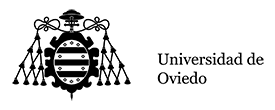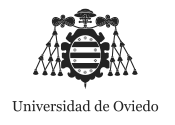Estudia
- Artes y humanidades
- Ciencias
- Ciencias de la salud
- Ciencias sociales y jurídicas
-
Ingeniería y arquitectura
- Doble Grado en Ingeniería Civil e Ingeniería de los Recursos Mineros y Energéticos
- Doble Grado en Ingeniería en Tecnologías y Servicios de Telecomunicación / Grado en Ciencia e Ingeniería de Datos
- Doble Grado en Ingeniería Informática del Software / Grado en Matemáticas
- Doble Grado en Ingeniería Informática en Tecnologías de la Información / Grado en Ciencia e Ingeniería de Datos
- Grado en Ciencia e Ingeniería de Datos
- Grado en Ingeniería Civil
- Grado en Ingeniería de los Recursos Mineros y Energéticos
- Grado en Ingeniería de Organización Industrial
- Grado en Ingeniería de Tecnologías Industriales
- Grado en Ingeniería de Tecnologías Mineras
- Grado en Ingeniería Eléctrica
- Bachelor´s Degree in Industrial Electronics and Automatics Engineering
- Grado en Ingeniería en Geomática
- Grado en Ingeniería en Tecnologías y Servicios de Telecomunicación
- Grado en Ingeniería Forestal y del Medio Natural
- Grado en Ingeniería Forestal y del Medio Natural (En extinción)
- Grado en Ingeniería Informática del Software
- Grado en Ingeniería Informática en Tecnologías de la Información
- Grado en Ingeniería Mecánica
- Grado en Ingeniería Química
- Grado en Ingeniería Química Industrial
- Grado en Marina
- Grado en Náutica y Transporte Marítimo
- Información, acceso y becas
Comunicación Persona Máquina
The course on 'Human-Computer Interaction', together with 'Databases',' Software engineering ',' Information systems', 'Web technologies' and' Testing and software deployment' compose the subject 'Software Engineering', which is integrated into the module 'Application Software'. This is a compulsory subject of eminently practical nature that will enable students to apply their programming knowledge by creating interfaces allowing for an adequate interaction with users. This course continues the formation in programming and software development that begins in the first academic year with basic training courses such as 'Introduction to programming' and 'Programming methodology' and more advanced courses taught during the first semester of the second academic year such as ' Data structures' and 'Programming technologies and paradigms'. This course has a markedly instrumental nature and therefore the acquired knowledge stands alone and can be directly applied to a project development. Additionally, this course provides a useful ground for the course on 'Web technologies' which is specific for information technology and taught on the fourth academic year.
Students enrolled in this course are expected to have basic programming skills. It is sufficient if students have previously passed the courses ‘Introduction to programming’ and ‘Programming methodologies’, both belonging to the first academic year.
| Competency | Description | |
| ECR17 | Ability to design and assess human-computer interfaces that guarantee providing accessibility and usability to computer systems, services and applications | |
| Learning outcome | ||
| IS22 | Design and develop a user interface for a computer application | |
Theoretical Contents:
T1 - Introduction to usability
T2 - Design of desktop user interfaces
T3 - Design of web-based user interfaces
Laboratory contents:
P.1. Graphical user interface (GUI) development on windows-based environments.
P.2. Web-based GUI development
P.3. Localization
IN-PERSON WORK | REMOTE WORK | |||||||||||
Lessons | Total hours | Theory lectures | Classroom practice sessions/ seminars/ workshops | Computer lab sessions | Hospital clinic practice | Group tutorship sessions | Interships | Assessment sessions | Total | Group work | Individual work | Total |
T1 | 2 | 1 | 1 | 1 | 1 | |||||||
T2 | 32 | 8 | 2,5 | 1 | 0,5 | 12 | 20 | 20 | ||||
T3 | 14 | 3,5 | 1 | 0,5 | 5 | 9 | 9 | |||||
T4 | 17 | 4 | 1,5 | 0,5 | 6 | 11 | 11 | |||||
T5 | 16 | 3,5 | 1 | 1 | 0,5 | 6 | 10 | 10 | ||||
P1 | 35 | 13 | 1 | 14 | 21 | 21 | ||||||
P2 | 18 | 6,5 | 0,5 | 7 | 11 | 11 | ||||||
P3 | 12 | 4,75 | 0,25 | 5 | 7 | 7 | ||||||
P4 | 4 | 1,75 | 0,25 | 2 | 2 | 2 | ||||||
Total | 150 | 20 | 6 | 26 | 2 | 4 | 58 | 92 | 92 | |||
MODALITIES | Hours | % | Totals | |
In-person | Theory lectures | 20 | 13.4% | 58 |
Classroom practice sessions / seminars | 6 | 4.0% | ||
Computer lab sessions | 26 | 17,3% | ||
Hospital clinic practice | ||||
Group tutorship | 2 | 1,3% | ||
Interships | ||||
Assessment sessions | 4 | 2,7% | ||
Remote | Group work | 92 | ||
Individual work | 92 | 61,3% | ||
Total | 150 | |||
Ordinary call:
Assessment will be continous consisting on two blocks: theory and laboratory work. Theory is marked over 30 points and practice over 70 points. Theory is assessed by means of individual in-person assignments carried out during the course. Laboratory work will be assessed by means of individual remote assignments which students must defend in a classroom activity. In order to pass the course, it is necessary to meet the following requirements: the sum of theory and laboratory work must reach 50 points or above and laboratory score alone must be 35 or above. It is also required that each one of laboratory assignments scores at least 40 percent of the maximum possible score.
If the previous requirements aren’t met, the course score will be the minimum between 4 and the weightened average.
Speciall call:
Special calls will be only assessed by means of individual remote assignments which students must defend in a classroom activity and they will be marked over a total of 70 points. In order to pass the course, it is necessary to meet the following requirements: the sum of the theoretical score obtained in an ordinary call and the laboratory score obtained in the described manner must reach 50 points or above and the mentioned laboratory work scores 35 or above. It is also required that each one of the laboratory assignments scores at least 40 percent over the maximum possible score.
If the previous requirements aren’t met, the course score will be the minimum between 4 and the weightened average.
Differential assessment: Both in the regular call and in the extraordinary call, the dates and characteristics of defenses and exams will be adapted according to each case of differential assessment.
The following books will find use during the delivery of this course:
· RedmondPyle, David; Moore, Alan. Graphical User Interface Design and Evaluation (GUIDE): a practical process. Prentice Hall, 1995. ISBN: 013315193X
· Shneiderman, Ben. Designing the user interface: Strategies for effective humancomputer interaction. AddisonWesley, 1998. ISSN/ISBN: 0201694972
· Dix, Alan; Finlay, Janet; Abowd, Gragory. Beale, Rusell. Humancomputer interaction. Prentice Hall Europe, 1998. ISSN/ISBN: 0132398648
The following links give access to software and documentation which are also used in this course:
http://www.oracle.com/technetwork/java/javase/downloads/index.html
http://www.oracle.com/technetwork/java/javase/documentation/apijsp136079.html
http://download.oracle.com/javase/tutorial/i18n/
http://developers.sun.com/dev/gadc/technicalpublications/articles/xliff.html

